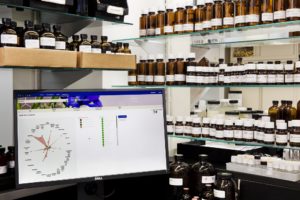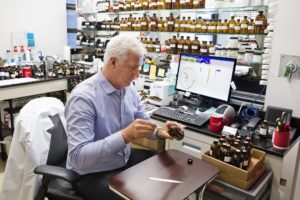
The Scent of an AI

(Africa Studio/Shutterstock)
“A fresh, fruity floral with an innovative twist in the top note.” That’s how master perfumer Dave Apel describes the first perfume created by artificial intelligence, which a Brazilian beauty company plans to start selling in 2019.
Now, machines can’t smell, at least not like humans can. But as a result of work that fragrance manufacturer Symrise AG did with IBM Research, you can now add “creating great perfumes” to the list of things that AI-powered robots can do as well as humans.
Symrise and IBM collaborated to develop Philyra, an AI-based system that’s similar in some respects to Chef Watson, the IBM program that has turned some heads for its capability to create tasty recipes by utilizing interesting combinations of foods and flavors. The companies took that work as a starting point, and tweaked it to handle fragrances and formulas.
Richard Goodwin, an IBM Research scientist, says Philyra was trained to recognize similarities among the formulas for 1.5 million existing fragrances, which includes fine fragrance (such as women’s perfume and men’s cologne), as well as lesser scents used for shampoo, laundry detergent, and candles.
These formulas were labeled with information about associated human perceptions, as well as “success factors,” such as sales or a client’s initial approval or disapproval of a novel scent. Then a series of algorithms – including deep neural networks, support vector machines, and a random forest — find correlations hidden in the data.
The analysis starts with measuring the “distance” between fragrances, Goodwin says. “We train a model to predict how close… two fragrances are going to be, or given three fragrances, which two are going to be perceived as being more similar,” the IBM researcher tells Datanami. “That allows us to identify white spaces, those areas where there are no other fragrances that are in the catalog that’s close to one we’ve generated.”
Fragrance makers have about 3,000 raw ingredients to work with to create their concoctions, and each fragrance formula can have anywhere from seven to 100 ingredients. When compounded, those numbers create a nearly infinite number of potential combinations.
Philyra was able to learn which chemical substances can function as substitutes for others, which substances were good complements, and which ones weren’t. “We’re trying to ensure that we’re generating novelty,” Goodwin says. “But creating novelty wouldn’t be enough, because there are many things that are novel that don’t smell good.”
Dave Apel, who started in the perfumery business in 1980, says Philyra learned as any perfumer would. “It essentially learned the combinations of materials that are aesthetically pleasing, if you will — things that have been traditionally seen to work together, a kind of balance of how the materials are harmonious or not, and where there is signature within a fragrance,” he says.
“That’s an interesting thing for a machine to learn, and in fact it’s exactly the way that perfumers think about fragrances,” Apel continues. “So my job essentially was to interpret the data that was sent back, and to essentially target the system so that it would continue to develop more and more innovative fragrances in a more targeted fashion.”

Philyra was trained to identify similarity among 1.5 million fragrance formulas involving about 3,000 raw materials (Photo courtesy IBM)
After the training regimen, Philyra was set loose to go “free form,” to essentially create new combinations of ingredients. Apel and other master perfumers would provide some direction, such as a fruity or a musky scent, but Philrya was free to create any formulas, which were sent to a robotic system that actually compounded the recipe.
While about 99% of the AI-generated fragrances were not good, there were several that stood out in a good way. Symrise would then treat these novel scents as it would any human-created scent: by having a panel of human experts rate them. That feedback was then fed back into the system, which is how the results got better in an iterative manner.
As it was working through the development of Phlyra, Symrise was lucky enough to be approached by Brazil-based O Boticário, one of the largest beauty companies in the world. The companies worked together to develop a pair of perfumes that are gaining rave reviews, including the “fresh, fruity, floral” perfume, as well as a men’s cologne marked by a “smoky sensual, gourmand character.”
“We were all there when we presented it to them,” Atel says. “We got a standing ovation. They were stunned by the creativity that the system had generated. To be honest, we presented variations on the AI-generated fragrances that were ‘corrected’ by perfumers, myself and another, and the AI-generated fragrance won. It was the one that was most interesting and innovative.”
The whole experience has Achim Daub, president of Symrise’s Scent & Care division, quite bullish on the prospects of AI in the fragrance business, which is estimated to drive $46 billion in annual sales.
“I’m not a technologist or a data scientist. I’m just a guy who makes sense out of perfumery,” Daub says. “So now using big data analytics and AI, you suddenly are able to surface the creative wisdom and breadth of hundreds of perfumes over hundreds of years, if you will, to create completely new combinations. That’s the fascinating aspect of where this lies.”
Related Items:
5 Things AI Is Better At Than You
Machine Learning, Deep Learning, and AI: What’s the Difference?




























